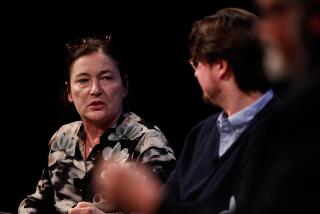‘The Original of Laura’ by Vladimir Nabokov, edited by Dmitri Nabokov
The Original of Laura (Dying Is Fun)
Vladimir Nabokov
Edited by Dmitri Nabokov
Alfred A. Knopf: 280 pp., $35
In the fall of 1976, a newspaper contacted Vladimir Nabokov in his Swiss refuge and asked him which books he had recently read. He responded with three typical titles: Dante’s “Inferno” (in Charles Singleton’s deliciously literal translation), a big, fat book about butterflies and his own work-in-progress, “The Original of Laura.”
The latter project had preoccupied him over the summer, despite a serious illness. It was, he told his correspondent, “completed in my mind.” The revisions went on while he was confined to a hospital bed, a febrile process he describes in some detail in his “Selected Letters”: “I must have gone through it some fifty times and in my diurnal delirium kept reading it aloud to a small dream audience in a walled garden. My audience consisted of peacocks, pigeons, my long dead parents, two cypresses, several young nurses crouching around, and a family doctor so old as to be almost invisible.”
Here was a description to whet the appetite of every Nabokov fanatic. If that’s how he discussed the book, the actual product had to be beyond imagining. Alas, the author died of congestive bronchitis in July 1977. And although he may have completed “The Original of Laura” in his mind, he had managed to transcribe only a small portion of the book onto index cards.
Those elegantly scribbled cards went into a Swiss vault, and then a long tug of war began. Nabokov had asked for the sketchy product to be burned after his death. His wife, Véra, who died in 1991, couldn’t bring herself to destroy his final work. Nor could his son, Dmitri, who eventually let drop a few stray comments about the book to interviewers. This dutiful son was vague about his father’s last effort, but he did allow that it was “the most concentrated distillation of [Nabokov’s] creativity.”
Increasingly, readers wondered whether this Holy Grail would ever be shared with the public. The answer arrived at by Dmitri Nabokov, after many years of agonized dithering, turns out to be yes. A 5,000-word excerpt appears in Playboy (a venue hotly defended by Dmitri, who noted that his father always enjoyed the skin magazine’s cartoons).
And now we have “The Original of Laura” in its entirety -- not so much a book as a devotional object, which photographically reproduces every single index card and even allows the reader to punch out these perforated simulacra and shuffle through them, just as the author did.
And what about, you know, the book? To be honest, the lavish packaging is more than a little disproportionate. “The Original of Laura” begins in the speedy, sexy, impressionistic vein of Nabokov’s late work. The heroine, Flora, is at a party, whose brittle atmosphere the author nails in a single sentence: “The party seemed to have degenerated into a lot of sober eyes staring at her with nasty compassion from every corner, every cushion and ashtray, and even from the hills of the spring night framed in the open french window.”
Flora is married to an older, fatter and considerably unhappier neurologist named Philip Wild, who has given the party a miss. Unencumbered by her fun-hating husband, Flora scurries over to a borrowed apartment and has a sexual encounter with a partner not worth describing -- or possibly with no partner at all.
At once we are given to understand that Flora, with her protective carapace of contempt, is not only the heart of the work but is also herself a walking, talking, fornicating metaphor. “Her exquisite bone structure,” we read, “immediately slipped into a novel -- became in fact the secret structure of that novel, besides supporting a number of poems.” No doubt we are encountering the original of “The Original of Laura,” who the enchanting author will now put through her metafictional paces.
Wrong. Nabokov zips through the early history of his heroine, complete with a sticky-fingered stepfather named Hubert H. Hubert (surely that rings a bell). But then, about halfway through his stack of index cards, he veers off in a new direction. Delectable, damaged Flora is rudely discarded.
Instead, the focus switches to Philip Wild, who is determined to kill himself. What he has in mind is a strange process of subtraction: He imagines himself as a kind of stick figure on a mental blackboard, then slowly erases parts of his body, starting with his toes. Dying, he imagines, will be fun, since “auto-dissolution afforded the greatest ecstasy known to man.”
Nabokov was 77 years old and in failing health when he wrote those words. It is understandable that death suddenly struck him as a more urgent topic than Flora’s sexual betrayals and metaphoric malleability. He was staring at the end himself. The problem is that Wild’s portion of the narrative consists largely of jotted notes. Some cards include just a few words, while others seem to be bits and bobs copied out of the Oxford English Dictionary or other reference books. Of course, they give us some precious insight into Nabokov’s compositional methods. And there are glimpses, here and there, of his own physical trials, all the more moving for being unvarnished. But their scholarly interest far outweighs their value as art.
To be blunt: As a novel -- even as the sketch of a novel, with operating instructions enclosed -- “The Original of Laura” is largely an exercise in frustration. There are enough Nabokovian touches, at least in the earlier section, to tantalize any devotee of the English language. But if you want to see the author truly reckon with the joys of dissolution, turn to the last page of “Transparent Things,” in which he addresses “not the crude anguish of physical death but the incomparable pangs of the mysterious mental maneuver needed to pass from one state of being to another.” It doesn’t get more original than that.
Marcus is the author of “Amazonia: Five Years at the Epicenter of the Dot.Com Juggernaut” and an editor at the Columbia Journalism Review. He blogs at House of Mirth (housemirth.blogspot.com).
More to Read
The biggest entertainment stories
Get our big stories about Hollywood, film, television, music, arts, culture and more right in your inbox as soon as they publish.
You may occasionally receive promotional content from the Los Angeles Times.










